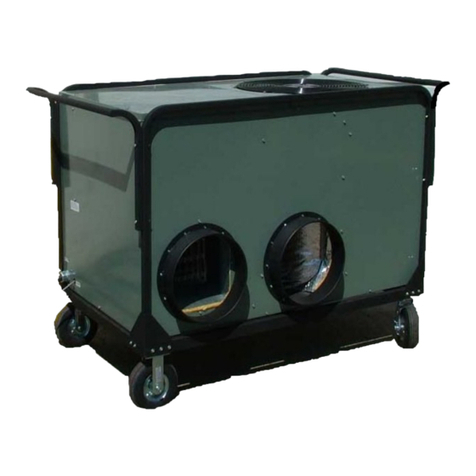
buttons. Press and hold the DOWN arrow button then press the UP arrow
button. The display will switch to FAN SPD and display HIGH. As soon as the
display reverts to normal operation the fan speed will change to HIGH. To
switch back to LOW fan speed press and hold the UP button and then press
the DOWN arrow the display will switch to FAN SPD LOW and as soon as the
display reverts to normal operation the fan will switch back to the LOW speed.
Basic operation of the ECU
Initially pressing the on/off key on the controller, the ECU will start heating
with resistance heat or cooling 5 minutes after power is applied to it and the
asterisk appearing on the display.
On subsequent restarts there is a (5) five-minute delay built into the operating
program to allow the unit to equalize refrigerant pressures before it restarts
again. This is normal operation. This is not adjustable and is a mandatory
period required between cycles to insure that the internal pressures can
equalize before the ECU attempts to start.
The ECU will cycle on and off to maintain the set temperature. During startup
in a warm humid condition it may require a significant amount of time for the
ECU to reach the desired temperature. The ECU will dehumidify the space
first, and then lower the temperature second.
The ECU during it’s heating mode at certain outside temperatures will
develop frost and ice on the outside coils. In order to maintain the optimum
conditions for heating the ECU will automatically go into a defrost mode to
clear the coils. The resistance heater will continue to operate during the
defrost mode. Although the heatpump will not be supplying heat for a short
time and the return air will feel cool to the inside occupants, this is normal and
will only last a short time. Dependant on outside temperatures and conditions
the defrost control is automatically controlled by the freeze sensor located on
the condenser coils and no user intervention is required. This is normal
operation and immediately upon the defrost of the condenser coils the unit will
again go back to normal heating mode and start to supply heat pump heat to
the shelter.
Heating options for ECU Switch position
Normal Operation Cold Weather
AC & Heating R Heat Only
In extreme cold conditions the heatpump will become ineffective in heating
the shelter, the user should then select the cold weather R heat only setting.





























